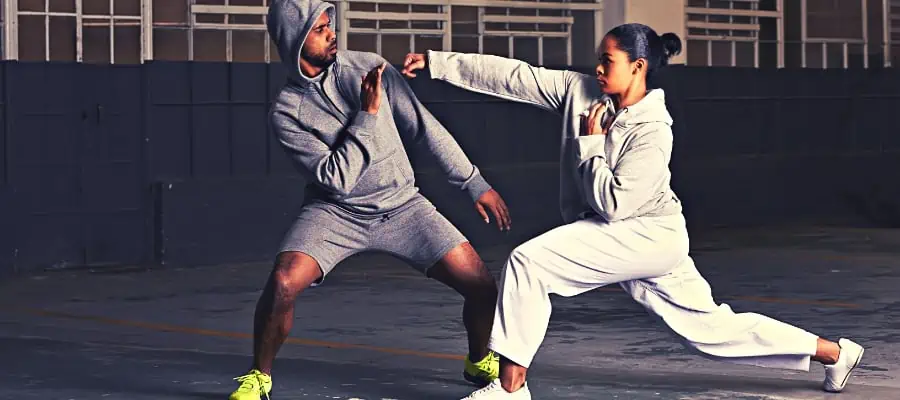Martial arts are often scrutinized for their practicality in real-life conflict scenarios, and Kung Fu is no exception. With its deep roots in Chinese philosophy and history, Kung Fu is one of the most well-known Chinese martial arts, embodying a rich cultural legacy alongside its fighting techniques. Yet, when it comes to the chaotic and unpredictable nature of street fights, the question arises:
Can kung fu survive a street fight? Kung Fu teaches discipline and specific fighting techniques but may not suit street fights, which are unpredictable and rule-less, unlike the structured setting of martial arts training. Therefore, adapting Kung Fu’s traditional methods for real-life defense is crucial.
Critics argue that the effectiveness of Kung Fu, much like any martial art, greatly depends on the training style and the realism incorporated into the self-defense techniques. As street fights can be volatile and dangerous, a martial artist must be prepared for the unexpected, possibly setting aside traditional forms for more improvisational and situational responses. The conversation about Kung Fu’s application in real-life defense situations continues, with many proponents and detractors weighing in on its merits.
Analyzing Kung Fu’s Applicability in Real-World Scenarios

In assessing the applicability of Kung Fu in real situations, one must consider its effectiveness in combat and its practical application compared to other martial arts.
The Principle of Effectiveness in Combat
Kung Fu is a martial art steeped in philosophy and tradition, prioritizing fluidity and technique. While it offers a variety of attacks and takedowns, its effectiveness for self-defense can vary. Training in Kung Fu emphasizes forms and patterns, which may not always translate to the unpredictability of a street fight.
Techniques from styles like Wing Chun could be practical due to their focus on close-quarters combat. However, the versatility and adaptability required in a chaotic situation might not be the strong suit of all Kung Fu styles.
Comparison with Other Martial Arts
Kung Fu’s practical application may seem limited when stacked against other disciplines such as Brazilian Jiu-Jitsu (BJJ), Muay Thai, or Mixed Martial Arts (MMA). Arts like Muay Thai and BJJ emphasize live sparring and realistic, resistant training, which can better prepare practitioners for real combat scenarios. MMA fighters often incorporate boxing, wrestling, and Jiu-Jitsu to handle various ranges and tactics, highlighting a more comprehensive approach to fighting than Kung Fu might offer.
Moreover, Krav Maga‘s focus on self-defense and aggressive takedowns has been tailored for combat, which contrasts with Kung Fu’s more measured and traditional approach that could be seen as less effective in a street fight scenario.
Practical Training Elements for Street Readiness

When considering the effectiveness of Kung Fu in street fights, it’s pivotal to focus on practical training elements that foster street readiness. The core components comprise developing situational awareness and reflexes, ensuring the efficiency of Kung Fu techniques, and understanding the differences between internal and external Kung Fu practices.
Developing Situational Awareness and Reflexes
Training in Kung Fu should emphasize heightening situational awareness to preemptively recognize potential threats. This involves regular practice to sharpen reflexes for rapid response to unexpected attacks. Live sparring exercises simulate real-life scenarios, advancing one’s capability to react defensively with both speed and poise. Moreover, consistent practice augments muscle memory, crucial for effective hand-to-hand combat.
Kung Fu Techniques and Efficiency
Incorporating efficient Kung Fu techniques in street altercations means mastering strikes, kicks, and grappling. While cinematic depictions often showcase elaborate moves, practicality demands refined skills—punching, elbow strikes, knee strikes—and straightforward footwork. The significance of delivering powerful blows with minimal effort can be the difference between subduing an opponent or becoming overpowered.
Internal Versus External Kung Fu
Differentiating external from internal Kung Fu styles is critical; external focuses on physical strength and performance, while internal styles like Tai Chi aim to cultivate balance and qi (energy). Although internal styles are less aggressive, they boast the enhancement of fluidity and control, which potentially offer an advantage in overcoming a more forceful opponent. However, mastery requires immense dedication and discipline, as performance under duress does not equate to the calm of the dojo.
Each aspect of Kung Fu outlined above contributes to the overall effectiveness of a street fight. Yet, it’s the discipline and real-world training that ultimately determine its utility in hand-to-hand combat situations.
If this article was helpful to you, don’t forget to add it to your Pinterest board.
Recent Posts
What is Manachai's Fighting Style? Unveiling Muay Thai Mastery
Manachai, a celebrated figure in the Muay Thai world, has captivated audiences with his exemplary martial prowess. Hailing from the heartlands of Thailand, his name is synonymous with the art of...
What Was Chamuekpet Hapalang's Fighting Style? Unveiling Techniques
Chamuekpet Hapalang was a renowned figure in the world of Muay Thai (record 200-48-2), embodying a fusion of Muay Bouk and Muay Khao styles. Originating from Thailand, the art of Muay Thai is known...

